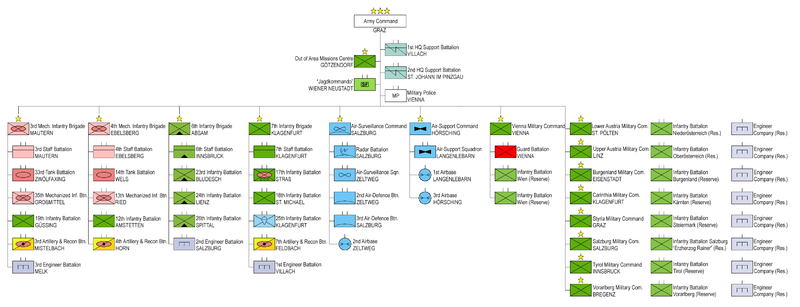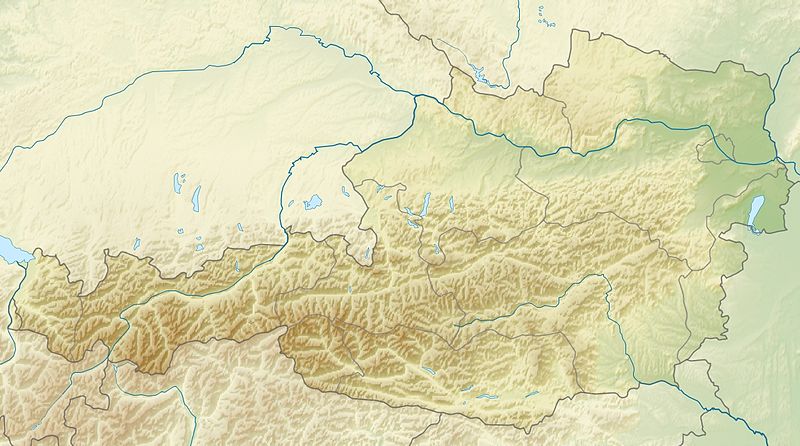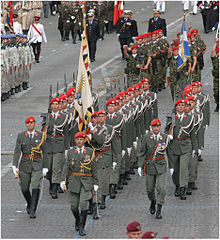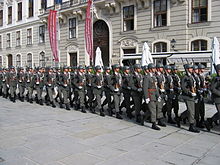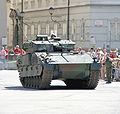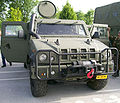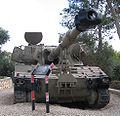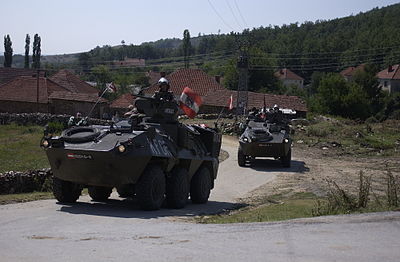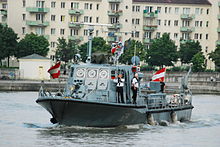- Austrian Armed Forces
-
Austrian Armed Forces
Bundesheer
Roundel of the BundesheerFounded November 8, 1918 Current form May 15, 1955 Service branches Land Forces
Air ForcesHeadquarters Vienna Leadership Commander-in-Chief President Heinz Fischer Minister of Defence Norbert Darabos Chief of staff General Edmund Entacher Manpower Military age 18 Conscription 6 months Available for
military service1,914,800 males, age 16-49,
1,870,134 females, age 16-49Fit for
military service1,550,441 males, age 16-49,
1,515,365 females, age 16-49Reaching military
age annually48,967 males,
46,633 femalesActive personnel 19,000 (60% conscripts) Reserve personnel 72,000 Expenditures Percent of GDP 0.9% (2005) Industry Domestic suppliers Steyr Mannlicher
Steyr-Daimler-Puch
Glock Ges.m.b.H.Foreign suppliers  France
France
 Germany
Germany
 Italy
Italy
 United States
United StatesRelated articles History Military history of Austria
Austro-Hungarian ArmyThe Österreichisches Bundesheer (German for "Austrian Federal Army", officially referred to as the Austrian Armed Forces in English), is the name for the military of the Republic of Austria.
The main branches are the Land Forces Command (Kommando Landstreitkräfte; KdoLaSK), Air Command (Kommando Luftstreitkräfte; KdoLuSK), Mission Support (Kommando Einsatzunterstützung; KdoEU), International Missions (Kommando Internationale Einsätze; KdoIE), Command Support (Kommando Führungsunterstützung; KdoFüU) and Special Forces Command (Kommando Spezialeinsatzkräfte; KdoSEK).[1]
Austria, a landlocked country, today has no navy; in the period 1958 to 2006 however the Austrian army operated a naval squadron of patrol boats on the River Danube. That duty has been assumed by the Bundespolizei (Federal Police).
Contents
History
Main article: Military history of AustriaBetween 1918 and 1921, the Austrian semi-regular army was called Volkswehr ("People's Defence"), and fought against Yugoslavian army units occupying parts of Carinthia. It has been known as "Bundesheer" since then, except when Austria was a part of Nazi Germany (1938–1945; see Anschluss). The Austrian Army did develop a defense plan in 1938 against Germany[citation needed], but politics prevented it from being implemented.
In 1955, Austria declared its Everlasting Neutrality and made neutrality a constitutional law. The Austrian Military's main purpose since then has been the protection of Austria's neutrality.
With the end of the Cold War, the Austrian military have increasingly assisted the border police in controlling the influx of illegal immigrants through Austrian borders. The war in the neighbouring Balkans resulted in the lifting of the restrictions on the range of weaponry of the Austrian military that had been imposed by a 1955 international treaty.
Mission
The main constitutional tasks of today's Austrian military are:
- to protect the constitutionally established institutions and the population's democratic freedoms.
- to maintain order and security inside the country.
- to render assistance in the case of natural catastrophes and disasters of exceptional magnitude.
Organization
Under the constitution, the president is the nominal commander in chief of the armed forces. In reality, the chancellor has operational authority, exercised through the minister for national defense. The chancellor also chairs the National Defense Council, which has as its members a vice chairman, the minister for national defense, an appointee of this minister, the general troop inspector of the armed forces, and a parliamentary representative. The minister for national defense, acting in cooperation with the minister for interior, coordinates the work of the four major committees under the National Defense Council: the Military Defense Committee; the Civil Defense Committee; the Economic Defense Committee; and the Psychological Defense Committee. The general troop inspector acts as the senior military adviser to the minister for national defense, assists the minister in the exercise of his authority, and, as head of the general staff, is responsible for planning. However, the army commander exercises direct operational control of the Bundesheer in both peacetime and wartime.
Article 79 of the constitution, as amended in 1985, states that the army is entrusted with the military defense of the country. Insofar as the legally constituted civil authority requests its cooperation, the army is further charged with protecting constitutional institutions and their capacity to act, as well as the democratic freedoms of the inhabitants; maintaining order and security in the interior; and rendering aid in disasters and mishaps of extraordinary scope. In administering the armed forces, the Ministry for National Defense is organized into four principal sections and the inspectorate general: Section I deals with legal and legislative matters; Section II handles personnel and recruitment matters, including discipline and grievances; Section III is concerned with troop command, schools, and other facilities, and it also comprises departments G-1 through G-5 as well as a separate department for air operations; and Section IV deals with procurement and supply, quartermaster matters, armaments, and ordnance (see fig. 12).
The general troop inspectorate is a separate section of the ministry with responsibility for coordination and fulfillment of the missions of the armed forces. It encompasses a general staff department, an attaché department, and planning and inspection groups.
The armed forces consist solely of the army, of which the air force is considered a constituent part. As of 1993, the total active complement of the armed forces was 52,000, of whom 20,000 to 30,000 were conscripts undergoing training of six to eight months. The army had 46,000 personnel on active duty (including an estimated 19,500 conscripts), and the air force had 6,000 personnel (2,400 conscripts).[2]
Army
Former structure
Under the area defense strategy, which had determined the army's organizational structure until 1993, the army was divided into three principal elements: the standing alert force (Bereitschaftstruppe) of active units, including the air division; the mobile militia (Mobile Landwehr), organized as eight mechanized reserve brigades to be deployed to key danger spots in the event of mobilization; and the stationary militia (Raumgebundene Landwehr) of twenty-six reserve infantry regiments organized for territorial defense. Both the mobile militia and the stationary militia were brought up to strength only in times of mobilization or during periods allotted for refresher training, usually three weeks in June. Training of conscripts was conducted by twenty-eight training and equipment-holding regiments (Landwehrstammregimenten). On mobilization, these regiments would disband, with their cadre reassigned to lead reserve units or form replacement regiments and battalions.
At the army level were a headquarters, guard, and special forces battalions and an artillery battalion at cadre strength. Two corps headquarters, one in the east at Graz and one in the west at Salzburg, would, on mobilization, command the provincially organized units in their respective zones. Each corps included artillery, antitank, antiaircraft, and engineering battalions and a logistics regiment, all on a cadre basis.
Each of the nine provincial military commands supervised the training and maintenance activities of their training and equipment-holding regiments. On mobilization, these nine commands would convert to a divisional headquarters commanding mobile militia, stationary militia, and other independent units.
The only active units immediately available in an emergency were those of the standing alert force of some 15,000 career soldiers supplemented by eight-month conscripts. The force was organized as a mechanized division consisting of three armored infantry brigades. Each brigade was composed of one tank battalion, one mechanized infantry battalion, and one selfpropelled artillery battalion. Two of the brigades had antitank battalions equipped with self-propelled weapons. The divisional headquarters was at Baden near Vienna; the three brigades were based in separate locations, also in the northeast of the country.
New structure
The New Army Structure—the reorganization plan announced in late 1991 and scheduled to be in place sometime in 1995—replaces the previous two-corps structure with one of three corps. The new corps is headquartered at Baden, with responsibility for the two northeastern provinces of Lower Austria and Upper Austria. Army headquarters will be eliminated, as will the divisional structure for the three standing brigades. The three corps—in effect, regional commands—will be directly subordinate to the general troop inspector. The three mechanized brigades will be placed directly under the new Third Corps at Baden, although in the future one brigade may be assigned to each of the three corps. The mobile militia will be reduced from eight to six mechanized brigades. Each of the nine provincial commands will have at least one militia regiment of two to six battalions as well as local defense companies.
Total personnel strength—both standing forces and reserves—is to be materially contracted under the new plan. The fully mobilized army will decline in strength from 200,000 to 120,000. The standing alert force will be reduced from 15,000 to 10,000. Reaction time is to be radically shortened so that part of the standing alert force can be deployed within hours to a crisis zone (for example, one adjacent to the border with Slovenia). A task force ready for immediate deployment will be maintained by one of the mechanized brigades on a rotational basis. Separate militia training companies to which all conscripts are assigned will be dismantled; in the future, conscripts will undergo basic training within their mobilization companies. Conscripts in the final stages of their training could supplement the standing forces by being poised for operational deployment at short notice.[3]
Personnel, Conscription, Training, and Reserves
Until 1971 Austrian males were obligated to serve nine months in the armed forces, followed by four days of active service every two years for training and inspection. In 1971 the period of initial service was reduced to six months, followed by a total of sixty days of refresher training in the reserves. In the early 1990s, about 45,000 conscripts completed their initial military training every year, and 80,000 reservists participated in some form of exercises each year.
Reducing the mobilization strength of the army to 120,000 under the New Army Structure plan is to be accomplished in part by limiting initial training of recruits to six months, followed by reducing the period allotted for refresher training from twenty years to ten years. Each reservist is to receive training over a twelve-day period every second year during his first ten years of reserve duty, generally not extending beyond the time he reaches his mid-thirties. The reduced need for conscripts corresponds to a lower pool of young men because of a declining birth rate. The existing availability of about 40,000 fit trainees annually as of 1993 is expected to fall to barely 30,000 by the year 2000 and to 26,000 by 2015.
Conscripts can choose to serve seven months instead of six and have a shorter reserve obligation. Some may serve their full obligation of eight months at one time and have no reserve obligations, but this may occur only at the army's discretion. Under a 1974 law, conscientious objectors can be assigned work as farm laborers, medical orderlies, or other occupations in lieu of military service. Exemptions from service are liberally granted—in 1992 about 12,000 persons were exempted, a great increase over the 1991 total of 4,500. The increase occurred after a new law, valid only for 1992 and 1993, no longer required young men to present their objections to the military in a credible way. Previously, that had not been the case. In 1990, for example, two young men rejected by the alternate service commission on the grounds that they did not present their beliefs in a credible manner were sentenced to prison terms of three months and one month, respectively.
Conscripts usually attain the rank of private first class by the completion of initial training. Those with leadership potential may serve a longer period to obtain noncommissioned officer (NCO) status in the militia. Those volunteering for the career service can, after three to four years, apply to attend the NCO academy and later a senior NCO course to qualify as warrant officers. Both regular and militia officer candidates undergo a one-year program of basic training. After a further three years, regular officer candidates attending the military academy at Wiener Neustadt and militia officer candidates undergoing periodic intensified refresher training qualify as second lieutenants. The reserve obligation of conscripts generally ends by the time they reach their mid-thirties; NCOs and officers usually end their reserve status at a later age depending on their rank and specialization. By the early 1990s, some 1.3 million men had completed their initial service and refresher training obligations and had no further active-duty commitment.
The military personnel system is an integral part of a comprehensive civil service system. The nine officer ranks from officer candidate through general correspond to grades I through IX of the civil service system. The highest grade, IX, may be occupied by a section chief (undersecretary), a career ambassador, or a three-star general. A grade VIII position may be held by a departmental counselor, a career minister, or a brigadier general. Salary levels are the same for both civil and military personnel in the equivalent grades, although various allowances may be added, such as flight pay or hazardous-duty pay.
Promotion is not based solely on merit but on position attained, level of education, and seniority. Officers with advanced degrees (for which study at the National Defense Academy qualifies) can expect to attain grade VIII before reaching the retirement age of sixty to sixty-five. Those with a baccalaureate degree can expect to reach grade VII (colonel), and those without university training will retire as captains or majors. Career NCOs form part of the same comprehensive personnel structure. It is common for NCOs to transfer at some stage in their careers to civilian status at the equivalent grade, either in the Ministry for National Defense or in the police or prison services after further training.
The system of promotion in the Austrian military, which offers no incentive for early retirement, means that the military is top-heavy with senior officers. The New Army Structure, which is intended to result in many fewer active-duty and reserve commands, compounds the difficulty. Personnel changes can be implemented only gradually, as the surplus of officers shrinks by attrition. As of 1991, the army had four officers of general rank, fifty-nine at the rank of brigadier general (one star), 155 colonels, and 254 lieutenant colonels. The education of career officers is conducted at the Maria Theresa Military Academy at Wiener Neustadt, thirty kilometers south of Vienna, which was founded in 1752. Young men who have completed their university entrance requirements are eligible to compete for places. The three-year course graduated 212 students in 1990. At the National Defense Academy in Vienna, which has a curriculum comparable to those of the National Defense University and the Army War College in the United States, operational and troop commanders of fieldgrade rank study for three years in preparation for general staff and command positions. The NCO school is located at Enns near Linz. Troop schools provide continuous specialized courses for officers and NCOs in artillery, air defense, armor, combat engineering, communications, and the like.
Women have never been accepted for service in the Austrian armed forces. In a public opinion survey in 1988, about 66 percent of those polled approved of opening the military to voluntary service by women; only 9 percent favored obligatory service. Although consideration had been given to opening certain specialties to female volunteers, the question is apparently in abeyance in an army already facing retrenchment.[4]
Air Division
Austria's air force (Fliegerdivision) is headquartered at Tulln-Langenlebarn Air Base twenty-five kilometers northwest of Vienna. The air force has as its missions the defense of Austrian airspace, tactical support of Austrian ground forces, reconnaissance and military transport, and search-and-rescue support when requested by civil authorities.
Until 1985, when the first of twenty-four Saab J-35Ö Drakens were delivered, the country had remained essentially without the capacity to contest violations of its airspace. The Drakens, reconditioned after having served the Swedish Air Force since the early 1960s, are armed only with a cannon, in accordance with the restrictions on missiles in the State Treaty of 1955. However, following Austria's revised interpretation of its obligations under the treaty, a decision was made in 1993 to procure Sidewinder air-to-air missiles. The first of these missiles will be purchased used from the Swedish air force. A higher performance model of the Sidewinder were purchased directly from the United States; deliveries began in 1995. French Mistral surface-to-air missiles (SAMs) were purchased to add ground-based protection against air attack. The first of the French missiles arrived in Austria in 1993; final deliveries were concluded in 1996.
Phaseout of the Drakens is scheduled to begin about 1995, and studies were under way to select a replacement, probably one that can be configured for both air defense and ground support missions. Possible replacements for the Draken are the United States F-16 and F-18. In addition to the two squadrons of Drakens, the air force has thirty-one Saab 105Oe fighters available for reconnaissance and close air support of ground troops; however, eight Saabs, borrowed from the combat squadrons, are regularly employed as jet conversion trainers. Acquired in 1970-72 after service in the Swedish air force, the subsonic Saabs are of limited value in a combat role. The helicopter fleet includes Agusta-Bell (AB) 204s (mainly medical evacuation), AB206s (training and liaison), and AB-212s (used by air-mobile troops and for light transport). French Alouettes are available for search-and-rescue tasks, including high mountain operations. The Bell OH-58 Kiowa, a scout helicopter, is mounted with a rapid-firing machine gun, but the air force lacks a true attack helicopter. Most of the helicopters, except the AB-212s, are becoming obsolete (see table 16, Appendix).
The air transport fleet is seriously deficient, a fact underscored by its inability to support the armed forces in their UN peacekeeping and humanitarian activities. The air force has at its disposal two Short Skyvans and twelve Pilatus PC-6s that can handle only light cargoes. Among air force priorities—unfulfilled because of budgetary constraints—is the procurement of three to six medium-transport aircraft.
The air force is organized into a division of three flying regiments and one radar (air defense) regiment.
Air Regiment I at Tulln-Langenlebarn consists of the light transport squadron plus one helicopter wing of AB-206s and OH-58s.
Air Regiment II at Graz-Thalerhof, Aigen in Ennstal, and Zeltweg consists of the air interceptor wing of Drakens and a wing of two Alouette helicopter squadrons.
Air Regiment III at Linz-Hörsching consists of the fighter-bomber wing of Saab 105Oes and a helicopter wing of AB204s and AB-212s.
An air defense battalion equipped with 20mm and 35mm antiaircraft guns and a variety of radar systems is attached to each air regiment.
The Central Flying School at Zeltweg is equipped with Saab 91D Safirs and Saab 105Oes, while transport pilots train on PC7s . Austrian pilots are sent to northern Sweden for training in operation of the Drakens.[5][5]
Appearance
The service uniform of the Austrian army is olive drab, the dress uniform is grey; for formal occasions a white uniform may be worn. The air force uniform is identical, with the addition of wings worn on the right jacket breast—gold for officers and silver for enlisted personnel. Branches of service are identified by beret colors: scarlet for the honour Guard; green for infantry; black for armor; cherry for air force; and dark blue for quartermaster. Insignia of rank are worn on the jacket lapel of the dress uniform (silver stars on a green or gold shield) and on the epaulets of the field uniform (white, silver or gold stars on a olive drab field).[6] [7]
Rank
Of the eight enlisted ranks, only a sergeant (Wachtmeister) or above is considered an NCO. There are two warrant officer ranks—Offiziersstellvertreter and Vizeleutnant. The lowest commissioned rank of officer candidate (Fähnrich)--is held by cadets at the military academy and by reserve officers in training for the rank second lieutenant. To maintain conformity with grade levels in the civil service, there are only two ranks of general in the personnel system—brigadier general (one star) and general lieutenant (three stars). However, the ranks of major general (two stars) and full general (equivalent to four stars) are accorded to officers holding particular military commands.[8]
Equipment
See also: List of former equipment of the Austrian ArmyThe Austrian military has a wide variety of equipment. Recently, Austria has spent considerable amounts of money modernizing its military arsenal. Leopard 2 main battle tanks, Ulan and Pandur infantry fighting vehicles, C-130 Hercules transport planes, S-70 Black Hawk utility helicopters, and Eurofighter Typhoon multi-purpose combat aircraft have been purchased, along with new helicopters to replace the inadequate ones used after the 1999 Galtür Avalanche.
Austria's current equipment includes:
Infantry weapons
- Glock 17 (Pistole 80) sidearm
- FN FAL (StG 58) service rifle, only used by Austrian Guard Company
- Steyr AUG (StG 77) service rifle
- Steyr SSG 69 sniper rifle
- MG 74 machine gun
- FN MAG machine gun (only used on Leopard 2A4 tanks, ULAN tanks and Black Hawk helicopters)
- Browning M2 (üsMG M2) heavy machine gun
- BILL 1 Anti-tank guided weapon (PAL 2000 "Bill")
- Carl Gustav recoilless rifle (PAR 66/79)
- L16 81mm Mortar (mGrW 82)
- Hirtenberger M12-1111 120mm heavy mortar (GrW 86)
Only used by Special Forces:
- Steyr TMP submachine gun
- FN P90 submachine gun
- Remington 870 shotgun
- Steyr HS .50 anti-materiel rifle
- Barrett M95 anti-materiel rifle
Vehicles
- Leopard 2A4 main battle tanks - 114
- SK-105 Kürassier tank destroyers - 48 (+71 in storage)
- ULAN infantry fighting vehicles - 112
- Schützenpanzer A1 armored personnel carriers - 261 (+ 106 in storage)
- Pandur I armored personnel carriers - 71
- Dingo 2 protected vehicles - 35
- Iveco LMV - 150
- Puch G 4x4
- Pinzgauer
- M109 A2/A5Ö self-propelled artillery - 80
- Bergepanzer M 88A1 armoured recovery vehicle
- Bergepanzer Greif armoured recovery vehicle
- M578 Light Recovery Vehicle
- Pionierpanzer A1 armoured engineer vehicle
- Bandvagn 206 tracked articulated, all-terrain carrier
- Unimog - 268
- Steyr 12M18 truck - 1,000
- ÖAF SLKW truck
Air defence systems
- 20 mm Fliegerabwehrkanone 65/68 (FlAK 65/68)
- Zwillingsflugabwehrkanonen 35 mm (ZFlAK 85)
- Mistral missile
Aircraft
- Eurofighter Typhoon multi-role fighters - 15
- Lockheed C-130 Hercules transport aircraft - 3
- Saab 105 training aircraft - 28
- Pilatus PC-6B Porter transport aircraft - 13
- Pilatus PC-7 Turbo Trainer training aircraft - 16
- Sikorsky UH-60 Black Hawk transport helicopters - 9
- Bell OH-58 Kiowa Reconnaissance helicopters - 11
- Agusta Bell 212 Twin Huey transport helicopters - 23
- Alouette helicopters - 24
-
Lockheed Martin Hercules C.Mk 1P '8T-CB' of 'Flight Regiment 3'
-
Sikorsky S-70A-42 Black Hawk '6M-BH' of 'Flight Regiment 1'
Rank Insignias of the Austrian Army
Commissioned Officers: (Offiziere)
Insignia 










Title Officer Cadet Second Lieutenant First Lieutenant Captain Major Lieutenant Colonel Colonel Brigadier General Major General Lieutenant General General Ranks in Austria Fähnrich Leutnant Oberleutnant Hauptmann Major Oberstleutnant Oberst Brigadier Generalmajor Generalleutnant General NATO Code OF-D OF-1 OF-2 OF-3 OF-4 OF-5 OF-6 OF-7 OF-8 OF-9 Non-Commissioned Officers: (Unteroffiziere)
Insignia 





Title Sergeant Master Sergeant Staff Sergeant Warrant Officer III Warrant Officer II Warrant Officer I Ranks in Austria Wachtmeister Oberwachtmeister Stabswachtmeister Oberstabswachtmeister Offiziersstellvertreter Vizeleutnant NATO Code OR-5 OR-6 OR-7 OR-8 OR-9 Enlisted With Rank: (Chargen)
Insignia 


Title Lance Corporal Corporal Master Corporal Ranks in Austria Gefreiter Korporal Zugsführer NATO Code OR-2 OR-3 OR-4 Enlisted Without Rank: (Rekrut)
Insignia 
Title Private Rank in Austria Rekrut NATO Code OR-1 International operations
Austrian Army APCs on patrol in Kosovo.
Currently (August 10, 2009) there are Bundesheer forces in:
- Bosnia and Herzegovina
- EUFOR (former SFOR)
- 345 personnel
- since 2 December 2004 under European Union Command
- Golan Heights
- United Nations Disengagement Observer Force Zone (UNDOF)
- 379 personnel
In March 2001 three Austrian military personnel were serving as part of ISAF.[9]
Traditions
Some of the traditions of the old Austro-Hungarian Army continue to be carried on in Bundesheer. For example, the most famous regiment in the Bundesheer is the "Hoch und Deutschmeister Regiment", now known as Jägerbataillon Wien 1 based in "Maria Theresien Kaserne", named after Empress Maria Theresa of Austria. Also nearly every other regiment of the Bundesheer carries on traditions of the famous Austro-Hungarian regiments like "Kaiserjäger", "Rainer", etc.
Austrian Special Operations Forces
Former Austrian Patrol boat on the Danube river
The Jagdkommando (lit. Hunting Command) is the Austrian Armed Forces' Special Operations group. The duties of this elite unit match those of its foreign counterparts, such as the United States Army Special Forces, being amongst others Counter-terrorism and counter-insurgency. Jagdkommando soldiers are highly trained professionals whose thorough and rigorous training enables them to take over when tasks or situations outgrow the capabilities and specialisation of conventional units.
In 1958 the patrol boat RPC Oberst Brecht was commissioned as a naval squadron of the Army to patrol the Danube in protection of the country's neutrality. The larger vessel RPB Niederösterreich was also commissioned 12 years later. The squadron comprised two officers and thirty men. The company which built the vessels closed in 1994. With the fall of Communism and the inability to maintain and repair the vessels, the squadron was disbanded in 2006.[10]
See also
- Jagdkommando
- Austrian air defense
- Heeresgeschichtliches Museum
- Heeresnachrichtenamt
- Theresian Military Academy
- Austrian Military Police - Kommando Militärstreife & Militärpolizei (Kdo MilStrf&MP)
References
 This article incorporates public domain material from websites or documents of the Library of Congress Country Studies.
This article incorporates public domain material from websites or documents of the Library of Congress Country Studies.- CIA World Factbook, 2005
- Christopher Eger, The Final End of the Austrian Navy, on the site militaryhistory.suite101.com, 2006
- ^ "Die Führungsstruktur des Österreichischen Bundesheeres" (in German). Österreichs Bundesheer. Bundesministerium für Landesverteidigung und Sport. 2009. http://www.bmlv.gv.at/organisation/gliederung/gliederung.shtml. Retrieved 2009-05-12.
- ^ http://lcweb2.loc.gov/cgi-bin/query/r?frd/cstdy:@field%28DOCID+at0157%29 whic quotes "Jane's Defence Weekly [London], 17, No. 4, January 24, 1992, 117-24. "
- ^ http://lcweb2.loc.gov/cgi-bin/query/r?frd/cstdy:@field%28DOCID+at0158%29
- ^ http://lcweb2.loc.gov/cgi-bin/query2/r?frd/cstdy:@field%28DOCID+at0159%29
- ^ a b http://lcweb2.loc.gov/cgi-bin/query/r?frd/cstdy:@field%28DOCID+at0161%29
- ^ http://www.bmlv.gv.at/abzeichen/barettfarben.shtml
- ^ http://www.bmlv.gv.at/abzeichen/dienstgrade.shtml
- ^ http://lcweb2.loc.gov/cgi-bin/query/r?frd/cstdy:@field%28DOCID+at0162%29
- ^ http://www.isaf.nato.int/images/stories/File/Placemats/PLACEMAT.MARCH%2004..pdf
- ^ Eger (2006)
External links
- Ministry of Defence (BMLV)
- Overview of the Austrian Armed Forces
- Austrian Army reforms spawn hybrid recce and artillery units
Militaries of the member states of the European Union Military of Europe Sovereign
states- Albania
- Andorra
- Armenia
- Austria
- Azerbaijan
- Belarus
- Belgium
- Bosnia and Herzegovina
- Bulgaria
- Croatia
- Cyprus
- Czech Republic
- Denmark
- Estonia
- Finland
- France
- Georgia
- Germany
- Greece
- Hungary
- Iceland
- Ireland
- Italy
- Kazakhstan
- Latvia
- Liechtenstein
- Lithuania
- Luxembourg
- Macedonia
- Malta
- Moldova
- Monaco
- Montenegro
- Netherlands
- Norway
- Poland
- Portugal
- Romania
- Russia
- San Marino
- Serbia
- Slovakia
- Slovenia
- Spain
- Sweden
- Switzerland
- Turkey
- Ukraine
- United Kingdom
- Vatican City
States with limited
recognition- Abkhazia
- Kosovo
- Nagorno-Karabakh
- Northern Cyprus
- South Ossetia
- Transnistria
Other entities - European Union
- Sovereign Military Order of Malta
Categories:- Military of Austria
- Armed forces diving
- Conscript militaries
Wikimedia Foundation. 2010.

